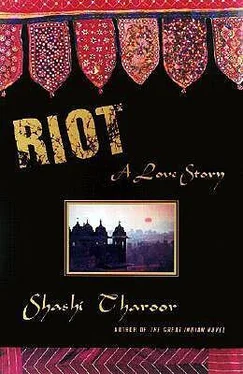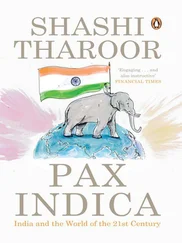And the Ram Janmabhoomi is not the only temple that was demolished by these marauding invaders and replaced with their filthy mosques. There are literally dozens more, all over our country. Do you know the story of the Kashi Vishwanath temple — or, as they prefer to call it, the Gyan Vapi mosque? No? Then listen: I will tell you.
It was just over three hundred years ago. The Kashi Vishwanath temple was one of the finest in Varanasi — what you call Benares, the city of temples, on the banks of the holy Ganga, the Ganges. It had been built as the result of a particularly auspicious dream — a dream by a princess, in which she was urged to consecrate this spot to Shiva, the god of destruction in our holy trinity. Inside the famed temple, which attracted millions of devotees from far and near, stood a magnificent shivalingam made of the purest emerald, a glittering phallic representation of the power of the godhead. Aurangzeb, the evil Muslim fanatic who reigned on the Mughal throne in Delhi, whose hatred for what he called idolatry was notorious, lusted for this prize. In 1669 he sent down one of his most feared generals with orders to smash the great temple, where he claimed “wicked sciences” were being practiced, and to bring the emerald lingam back to him.
The general he chose was an Abyssinian in his service who was known as Black Mountain. The name was apt in more ways than one. Black Mountain was a terrifying figure, immensely tall and broad-shouldered, black as the night, clad entirely in black, who always rode a black stallion. He marched on Varanasi with thousands of troops and something the defenders of the city had not faced before — dozens of cannons. And yet, despite this terrible adversary, how the Hindus of Varanasi fought! What a fearsome battle raged, Mr. Diggs! The Hindus defended their temple against impossible odds. Hundreds of Hindu soldiers and civilians were killed, but they could not indefinitely resist the overwhelming might of the invaders.
With defeat inevitable and the might of the Mughals about to descend on the temple, its purohit, the chief priest, made the supreme sacrifice. He seized the emerald lingam — which must have weighed much more than the priest himself— and dragged himself over to the temple well, known as the Well of Knowledge. There, with the forces of General Black Mountain almost upon him, the priest plunged into the waters of the well, clutching the lingam to his heart. Of course the weight of the precious object took him to the bottom, guaranteeing his death. His drowned body soon floated to the top, and was pulled out by Black Mountain’s men. But of the prized emerald itself there was no sign. A furious Black Mountain had the well dredged, but the lingam was never found. The Muslims said it must have slipped into an estuary and floated into the Ganges. But we Hindus know it was recovered by Shiva himself, taken out of the clutches of the invaders, who smashed his temple in their rage. It will return to Varanasi one day — but only when the vile mosque they have built in place of the fabled temple is replaced by a Shiva temple once again, and the princess’s original dream is once again fulfilled.
So you did not know about the Kashi Vishwanath, eh, Mr. Diggs? This time you will not hear those secularists cleverly decrying the lack of proof that there was ever a temple at that spot. For the proof is visible on the walls of the mosque itself — the back wall of the mosque is the wall of the ruined temple, complete with traces of its original Hindu carvings. You want more proof? In 1937, the British themselves examined the facts and concluded — officially, with a formal report — that the Gyan Vapi mosque stands upon the site of an ancient Hindu temple. Why should it have been any different with the Ram Janmabhoomi? You see, Mr. Diggs, it was very simple. Hindu temples were destroyed and replaced by mosques quite deliberately, as part of a conscious imperial strategy by the Muslim rulers to demoralize the local population and humiliate them. It was a way of saying, your Hindu gods are not so powerful, they had to bow before Muslim might, just as you too must subjugate yourselves to your new Mughal masters. That was the message of the Gyan Vapi mosque, and that was the message of the so-called Babri Masjid.
Now tell me, Mr. Diggs, is that a message that has any place in today’s free and independent India? Is it not time to restore the pride of the local people in their own traditions, their own gods, their own worth, by rebuilding the Ram Janmabhoomi temple?
These fancy-pants administrators you are going to meet, Lakshman and Gurinder Singh, want us to call off our agitation because of the riot. Call it off? We will never do that, Mr. Diggs. Never! Because if we do, the Muslims will proclaim victory. They will think they have won, they will crow about our humiliation, and then, believe me, they will come and slaughter us in our beds.
There is the old story of the trooper standing guard with two drawn swords, one in each hand. An enemy soldier comes to him and slaps him across the face. The trooper does nothing and the enemy sneeringly walks away. “Why didn’t you react when he slapped you?” asks a bystander. “But how could I?” replies the trooper. “Both my hands were occupied.”
That trooper, Mr. Diggs, is Hindu India. We have the swords in our hands but we do not use them even when we are repeatedly slapped. Well, those days are over. We know how to fight back now, with what is in our hands.
Guru Golwalkar, the longest serving Hindu leader this century said it very clearly, years ago: “The non-Hindu people in Hindustan must adopt the Hindu culture and language, must learn to respect and hold in reverence Hindu religion, must entertain no ideas but those of the glorification of the Hindu race and culture, i.e., they must not only give up their attitude of intolerance and ungratefulness towards this land and its age-old tradition but must also cultivate the positive attitude of love and devotion instead — in a word, they must cease to be foreigners, or may stay in the country wholly subordinate to the Hindu nation, claiming, deserving no privileges, much less any preferential treatment — not even citizen’s rights.” That is the message to these evil Muslims. As you say in your country, they better believe it.
No, the Ram Janmabhoomi temple will be built. No matter how many lives have to be sacrificed to ensure it. Our blood will irrigate the dusty soil, our sweat will mix the cement instead of water, but we will build the temple, Mr. Diggs. Mark my words. I have seen the light in the eyes of the young boys in our procession, even the very ones who were stabbed. It is not just religious fervor that makes their eyes shine, Mr. Diggs. It is the look of victory — as if some spark that has been stamped on for forty years has suddenly blazed again. This light will not be easily put out. It will shine, yes, and it will illuminate the whole of India with its flame.
from Randy Diggs’s notebook
October 14, 1989
Gurinder Singh: tough cop. Turban, fierce beard, Sikh. Smart. Honest? Talks straight. Curses (a lot). Drinks (a lot). “I’m Sikh enough not to smoke and Punjabi enough to drink like an Ambassador. I don’t mean the diplomatic piss-artist: I mean I guzzle like that steel behemoth of an Ambassador car we make here.”
GS and Lakshman make an odd pair at the helm of the district, but to all appearances a good one. They’re old buddies, sort of. This from an interview, unprintables deleted: “We weren’t exactly close friends in college. You can see the differences. Lucky’s an intellectual type with a sensitive soul. I’m down-to-earth, a man of action. He reads books in his spare time; I run. At college he studied English; I did history. He debated and edited the campus rag; I played [field] hockey. He’s vegetarian; I bunked [skipped] the mess hall the one day of the week they didn’t serve meat. He’s a teetotaler; I always had a bottle of rum under my bed. But I liked the fellow for two reasons: he’s smart and he’s honest. So when he ran for president of the College Union against one of my hockey teammates, a fellow with as much wood between his ears as in his hands on the field, I supported Lucky. Made me a bit unpopular with the rest of the hockey team. But he was the better candidate, and the better man. I’m glad to be working with him in bloody Zalilgarh.”
Читать дальше












